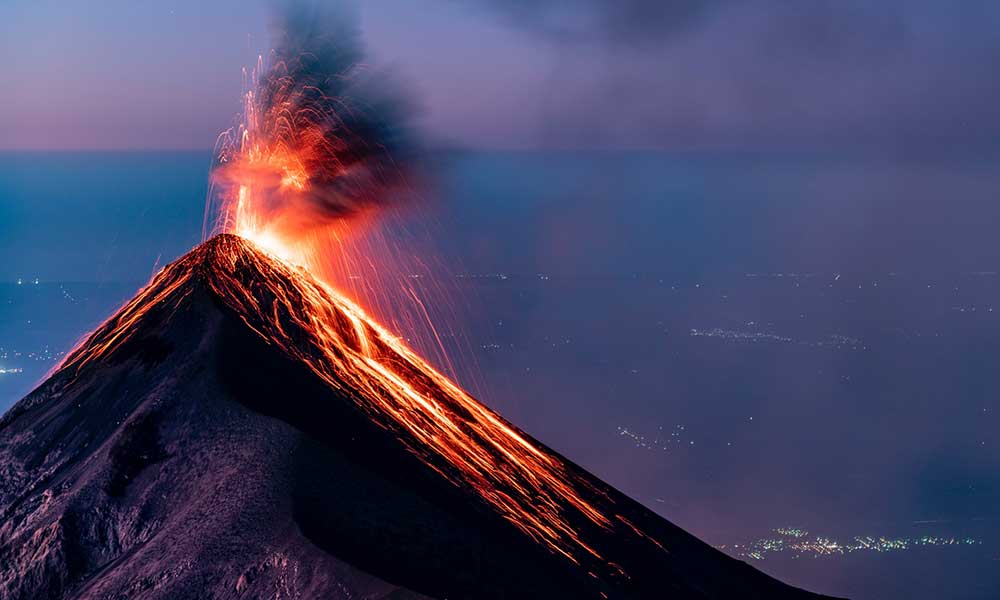To the uninitiated, volcano surfing, also known as volcano boarding, sounds like something the Human Torch does in his downtime, but it’s a real activity and it’s not as terrifying or life-threatening as you might think.
We were curious to understand if volcano surfing is safe. Turns out that volcano boarding has some risks but they don’t typically include being eaten alive by molten lava. We did say “typically”.
Is Volcano Boarding Safe?
The good news is that few people (if any) seem to have died while volcano boarding.
The bad news is that very few people have actually done it.
In his description of the activity, Zoltan Istvan mentioned “flying molten lava” and “lethal volcanic gases” as being the main threats, and he’s not wrong.
Aside from cuts, burns, and breaks, however, the main danger is posed by something known as “caver’s disease” or histoplasmosis, which is caused by breathing poisonous gases.
What Is Volcano Surfing?
As you probably guessed, volcano surfing doesn’t involve riding lava as it bubbles down volcanic slopes.
It does take place on the slopes of volcanos, though, with riders gliding over volcanic ash.
In that sense, it’s more like sandboarding than surfing, only it takes place over volcanic ash and not sand.
Because of this, volcano surfing is also known as volcano boarding, which makes more sense.
Most boarders use thick and wide boards, and they sit down as they slide, allowing them to stay in control and gain higher speeds.
Tips for Riding The Cerro Negro Volcano
Remember that volcano boarding is an extreme sport and it’s not something to be taken lightly.
There have been very few volcano boarding accidents and no deaths on these slopes, but you’re still moving rapidly over rough volcanic ash and will need to practice caution.
Make sure you have a good board and listen to whatever advice the experts provide.
Keep your mouth shut as you race down the slopes and don’t forget your goggles—if you get any of that ash in your eyes or mouth, you’ll know about it!
Research into Cerro Negro and volcano boarding in advance, make sure you have a high-quality metal or wooden board and plan your descent.
Taking these steps will help you to avoid becoming one of the few people to have seriously injured themselves while volcano boarding.
Who Invented Volcano Boarding?
Volcano boarding is said to have been invented by Zoltan Istvan, an entrepreneur, journalist, and politician.
Zoltan filmed himself volcano boarding on Mount Yasur in Vanuatu in 2002.
Zoltan would later describe volcano boarding as:
Boarding on an active volcano where immediate dangers present themselves or boarding an inactive volcano where there are no dangers.
The movements and style are similar, but one is decidedly more terrifying than the other.
Where Can You Volcano Surf?
Nicaragua is the place to be for volcano boarders.
The Cerro Negro active volcano, located in the west of the country, is where most boarders go.
They hike up the slopes and then slide down on boards made of wood or metal.
How Much Does It Cost To Go Volcano Boarding In Nicaragua?
There are tour operators that will take you out to Cerro Negro and let you experience volcano boarding for yourself.
These operators typically charge about $25 per person, with an extra $10 charged for access to the volcano and for someone to carry your board up the slopes.
That’s not all, though.
You’ll also need to think about travel to the region and staying in a hotel or hostel nearby.
Can You Go Volcano Surfing In Hawaii?
Although the Hawaiian Islands are volcanic, there are no slopes suitable for volcano boarding.
At the peak of Mauna Kea, you’ll only find snow while Kohala is filled with lush vegetation.
What Central American Country Has The Most Volcanoes?
Although Nicaragua is the place to be when it comes to volcano boarding, Guatemala has the most volcanos.
There are 37 of them in this small country.







